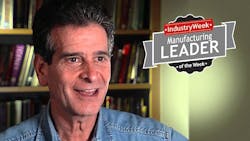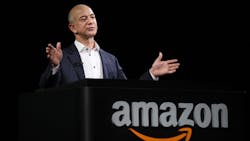The Tech Column is a weekly collection of stories, interviews, notes, news and more about the manufacturing tech world, published most Friday mornings here on IW.com. Have a story you think should be shared? Send an email to [email protected] or tweet @MattLaWell.
Those among us who have scaled the ladders of success, who have gathered the largest fortunes, who have notched the greatest accomplishments and will be remembered as history, those folks are often criticized for failures. And perhaps they should be.
They are also often criticized for successes. And perhaps they should be.
General Electric announced Monday morning that Jeff Immelt will step down after nearly 16 years in its top spot. He has a little less than seven weeks remaining as CEO, a little less than seven months remaining as chairman. John Flannery, the head of GE Healthcare, will succeed him in both positions.
The news did not come as a surprise, though perhaps the exact date and time did. After months of criticism from Trian Fund Management — which scooped up about 1% of all GE stock, $2.5 billion worth, in October 2015 — Immelt’s years, months, weeks and days in charge were numbered. Trian demanded more return on its investment, of course, and this week, numerous analysts and media outlets pointed quickly to the value of the company’s stock as the reason for his resignation (or his ouster, if you pay heed to some talking heads).
In the short term, GE stock has been relatively stagnant and disappointing. In the long term, while its value has more than quadrupled from its most recent nadir during the financial crisis, it has performed more poorly than any of the other 29 DJIA components since September 2000 and has lagged behind the rest of the S&P 500 by about 75 percentage points. Those are rough numbers for any investor to consider.
This is the end, this right now. We can discuss what Immelt has done — his success, his fortune, his accomplishments — but just like sports trades cannot really be evaluated until years after players are shipped from one team to another, CEO legacies cannot be measured fully until all their decisions either pay off or fall flat.
The legacy Immelt leaves behind — the real health of GE and its ability to remain the leading digital industrial company — that will be discussed for years.
A lot of folks in the media like to mention that Immelt took control of GE on September 7, 2001, the Friday prior to a catastrophic tragedy. Heck, Immelt likes to mention that fact. During a dinner in March, just blocks from GE’s new headquarters in Boston, while discussing Donald Trump, health care, taxes and globalization, he mentioned his early days in charge, saying, “I spent the next three months in pure chaos. By Day 90, I could barely breathe.”
Imagine if he had just stepped down right then, after 90 days, overwhelmed by guiding a conglomerate through the aftermath of a terrorist attack, by navigating a path for the technological advances of the 21st century. How would we remember him then?
What if he had turned in his resignation some time during the financial crisis in late 2008 or the ensuing recession, or if he had just walked away, content with his accomplishments and happy to bask in the spoils of retirement, before shedding the conglomerate’s financial arm, or its appliances division? What would his legacy be?
Legacy is a funny word — in sports, in politics, in business, in life just in general. In his hit musical Hamilton, Lin-Manuel Miranda describes it as “planting seeds in a garden you never get to see.” Miranda took the longer view, a couple centuries of reflection and rumination working their way through his appreciation of our first treasury secretary. Not everybody is so lucky.
Will the seeds Immelt has planted over the last 16 years pay off for GE? Shareholders will talk about how the company’s stock dropped about 30% during Immelt’s time in charge. But with the passage of time, I think even they might see the new foundation he prepared for an old company.
Immelt built up the company’s presence in the oil and gas drilling market, then merged that division with Baker Hughes’. He made numerous acquisitions, perhaps none bigger than Alstom and its power business a couple years ago. He has reimagined GE for a new century, shelling out $4 billion just last year to develop analytical software, and another $2 billion on industrial additive manufacturing, according to Bloomberg. The company employs somewhere around 26,000 software developers writing code to enhance its products. He has reimagined GE as a manufacturer.
And if you look at numbers beyond stock price, he has helped triple annual sales for GE aviation to about $6 billion annually, with overall industrial sales checking in last year at $17.4 billion — up 185% from 2000 to 2016. (And if you do want to look at just share price, consider that GE paid out about $143 billion in dividends to shareholders since 2000 — more in 16 years than in the previous 108 years combined.)
During that same March dinner, Immelt fielded a question about what GE is today by discussing how much the company has changed. It no longer has a finger here, another there. “We were a conglomerate,” he said, “and now we’re a digital industrial company.
“The key thing is to keep trying to stay ahead. You go through these periods of change and you keep trying to stay ahead.”
Earlier this week, during a conference call with GE investors, Flannery said, “there (are) areas we need to improve on. … We know we can do better.” That’s true, at least financially. In terms of its structure and the industries where it’s really situated, Immelt seems to have left GE in a strong position. Only time, of course, will tell, but in hindsight, he could likely be praised far more than criticized.
Insane in the brain. / MIT Technology Review
FORECAST FOR AI, AUTOMATION? PRETTY HEALTHY: Automation and artificial intelligence applications will more than triple in the next two and a half years, according to research released Monday from Information Services Group. The numbers are the result of more than 500 business and IT leader responses — 16% of whom said they are currently applying automation and AI to at least one mission-critical business process. Among that same group, 51% said they plan to do so by 2019. 75% of respondents said automation AI will be critical to their competitive delivery of products and services, as well as central to strategic decision-making.
“Robotic process automation, autonomic systems and cognitive agents are making employees more productive by taking over routine, process-oriented task,” ISG Americas partner and president Todd Lavieri said. “At the same time, data scientists are using machine learning to find patterns and make predictions on vast troves of structured and unstructured data. These technologies, taken together, promise to usher in the next wave of enterprise growth and profitability.”
FIRST founder Dean Kamen, who created the Segway and believes in spreading the gospel of engineering. / LEGO
ROBOT OF THE WEEK: This week, rather than spotlight just one robot, how about we turn our attention to more than 160 of them? By this time next month, the FIRST Global Challenge will be under way from Washington, D.C. — a three-day “robot Olympics” for high school students from 157 different countries, as well as six continental representatives. FIRST, of course, was founded almost 30 years ago by engineer/inventor/entrepreneur/general rock star Dean Kamen, and has been focused on bringing more than 1 million kids into engineering ever since.
The greatest challenge for the teenagers competing this year will be access to clean water: per the “14 Grand Challenges for Engineering” IDed by the U.S. National Academy of Engineering, two alliances of three national teams will compete to remove contaminant particles from a simulated river during the competition.
SOME MORE GE NEWS: GE and Immelt started to spread their big news so quickly that a flurry of news releases later Monday and throughout the week were lost in the shuffle. In brief … GE engineers have devised a way to bundle gas turbine peakers and batteries, providing immediate power and a battery-turbine power cycle. Southern California Edison was the first to deploy this tech, back in April, at a pair of site near Los Angeles. It could lead to a 60% reduction in greenhouse gas emissions and air pollution. … The company also launched an expanded suite of Predix-based software application that use the IIoT to drive profit opportunities for power and utilities, and another field service management solution, ServiceMax, designed to transform service operations, reduce cost and — one of GE’s major talking points the last couple years — eliminate unplanned downtime. … And, for good measure, GE Power unveiled a new Predix-powered Digital Utility, connecting real-time machine and operations data with energy trading to drive up utilities profitability.
AUGMENTED REALITY FOR EVERYBODY: Vuzix M300 smartglasses are now available for purchase not only to industrial professionals, but also to the general public. I’m not really sure how they would be used out in the open just yet, but unleash the tech on enough engineering and programming brains, and I imagine we’ll see plenty of augmented reality out and about in our regular reality.
COMINGS, GOINGS and MONEY MATTERS: Rockwell Automation released a new FactoryTalk Analytics for Devices app earlier this week, designed to deliver instant analytics on the floor, specifically IDing device health. The related FactoryTalk TeamONE app focuses on reducing mean time to repair. … On Monday, Honeywell announced plans to dive a little deeper in cybersecurity, with an agreement to purchase Nextnine, which provides security management solutions and tech for industrial cybersecurity. …Honeywell Process Solutions also announced late last week that it will establish a new industrial cybersecurity center in Singapore. The center is slated to include an R&D lab, an advanced training facility and a security operations center, among other features. … Sunnova Energy Corp. announced Tuesday that it has raised almost $1 billion since March after closing a $140 million round of debt funding. Sunnova is a residential solar company that, true to its free market ethos, opposed the Solar Investment Tax Credit and been relatively outspoken about potential tariffs and price floors for the industry.
Soon, this will be the richest man in the world. / David McNew, Getty Images
QUOTE OF THE WEEK: “This tweet is a request for ideas. I’m thinking about a philanthropy strategy that is the opposite of how I mostly spend my time — working on the long term. For philanthropy, I find I’m drawn to the other end of the spectrum: the right now. … If you have ideas, just reply to this tweet with the idea (and if you think this approach is wrong, would love to hear that too). — Jeff Bezos, on Twitter, reportedly after repeated requests from The New York Times to discuss his philanthropy.
Bezos should become the world’s wealthiest person some time this year — perhaps even before the end of this current financial quarter if Amazon stock continues to rocket — and his philanthropy has been called into question. As noted by The Times, he has not signed Bill Gates’ and Warren Buffett’s Giving Pledge, he has never appeared among the Philanthropy 50, and he has given away about one-tenth of 1% of his personal fortune. He is, however, also just 53, and still earning a considerable sum. The longer he works, the more he could earn. During his 2010 commencement speech at Princeton, his alma mater, he said he had taken “the less safe path to follow my passion, and I’m proud of that.” This philanthropy tweet seems like he’s blazing his own path again.







